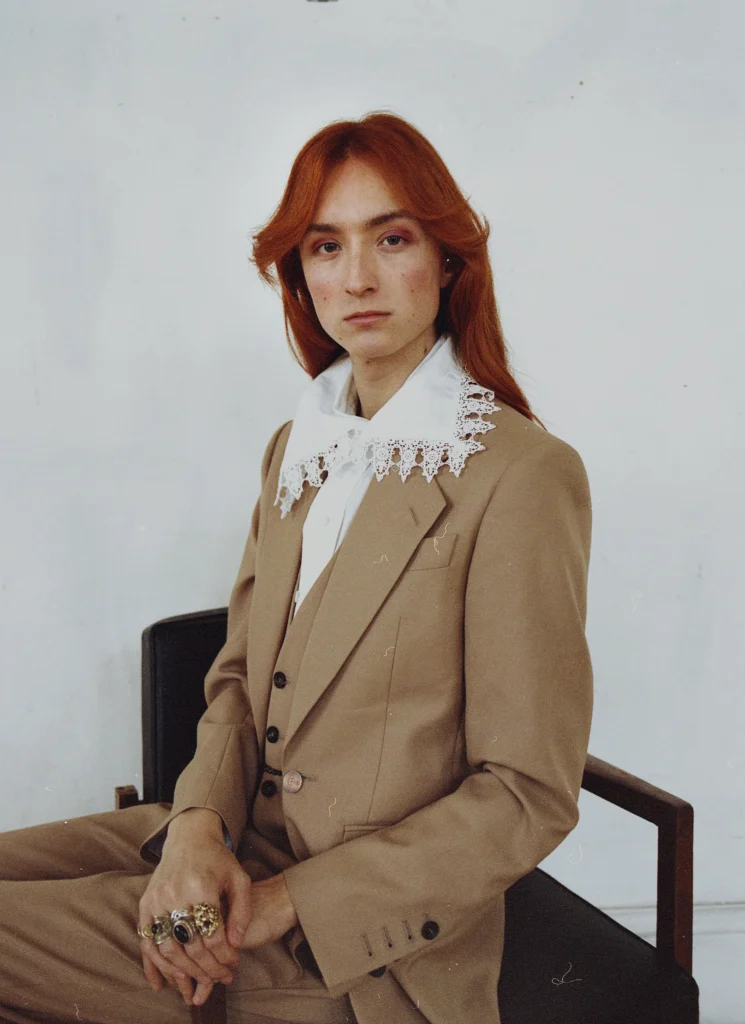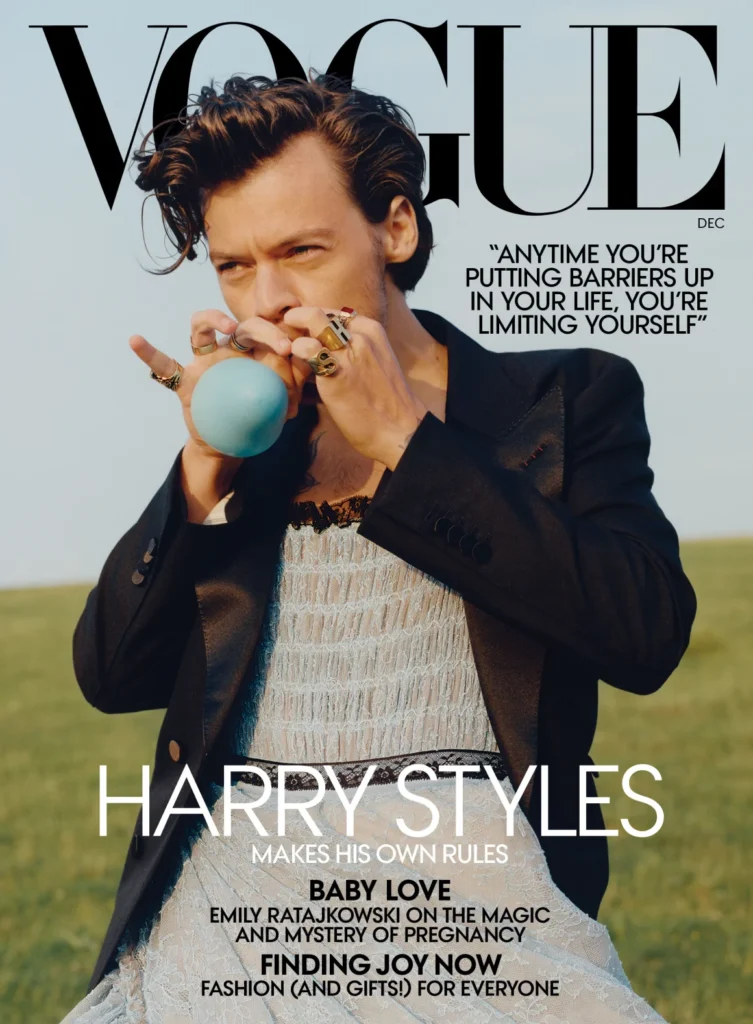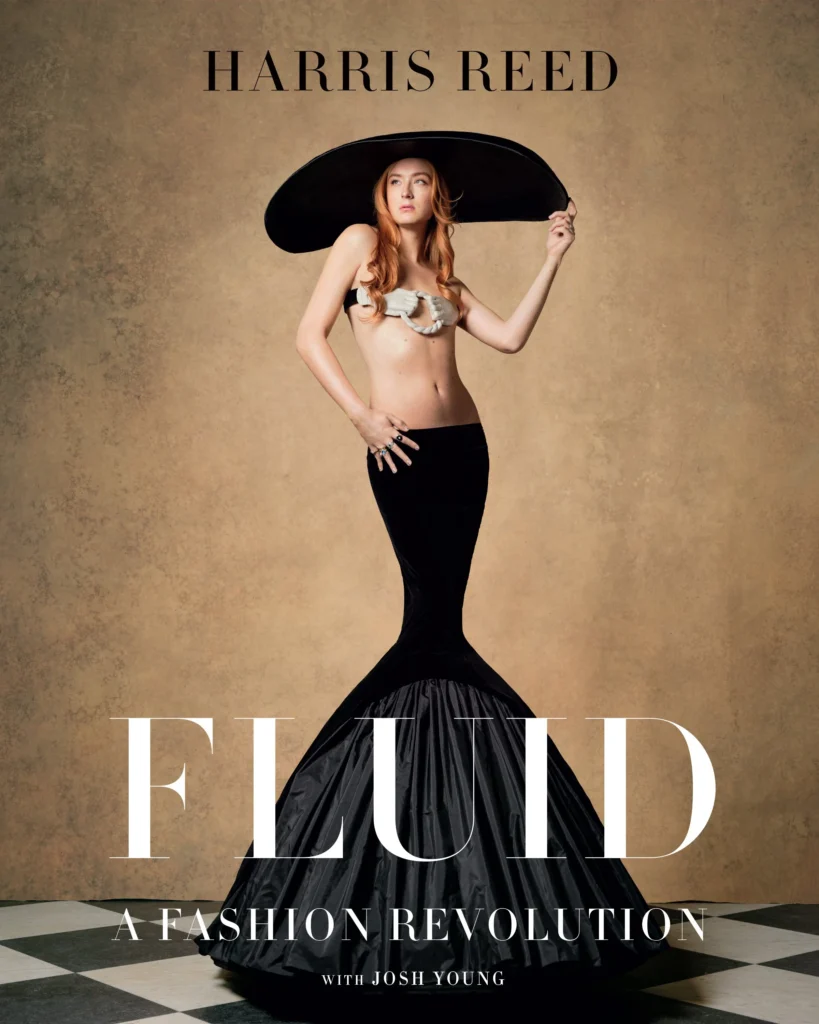
Harris Reed is a name that lights up the fashion world like a dramatic spotlight on a theatre stage. At just 29 years old, this British-American designer has become a bold voice for fluidity in clothing, blending high drama, rock star energy, and a deep respect for breaking gender rules. Born in 1996, Reed’s designs scream rebellion and romance, often called “Romanticism gone non-binary.” His work mixes sharp suits with flowing skirts, massive hats, and colours that pop like a live concert. Think David Bowie meets a Victorian opera singer, all wrapped in affordable fabrics made by hand. Reed’s story is one of grit, creativity, and fighting for a world where clothes don’t box people in. From dressing stars like Harry Styles to leading Nina Ricci, he has shaken up couture with his rock-opera vibe. This article dives into his life, style, and impact, showing why Reed is more than a designer; he’s a movement.
Early Life and Sparks of Creativity
Harris Reed came into the world on May 20, 1996, in Los Angeles, but his roots run deep in both America and Britain. His father, Nicholas Reed, is a British documentary filmmaker who won an Oscar, while his mother, Lynette Reed, is an American model turned candlemaker. Growing up between sunny Arizona and the buzz of LA, young Harris soaked up a mix of Hollywood glamour and desert freedom. But it was his family’s artistic world that first lit his fire. “My home was always full of storytellers,” Reed once said, recalling how his parents’ creative lives shaped his eye for beauty and drama.

As a kid, Reed felt different. He identifies as gay and genderfluid, terms that capture his fluid sense of self. In conservative Arizona, this wasn’t easy. School was a place of hiding, but art became his escape. He drew dresses and suits that twisted traditional ideas, inspired by glam rock icons like Bowie and the wild energy of the New York Dolls. “I was always the boy in the skirt at family parties,” he shared in his 2024 book Fluid: A Love Letter to the Power of Non-Conformity and Fashion. This book, a mix of memoir and sketches, traces his journey from a shy teen to a fashion force. It’s full of childhood tales, like making outfits from old curtains, hinting at the “demi-couture” he champions today, a style that’s handmade luxury on a real budget.
High school at The Center School in Seattle was a turning point. There, Reed explored theatre and design, staging his first “shows” with friends in borrowed costumes. “Theatre taught me that clothes are characters,” he said. This rock-opera flair, with its dramatic poses and emotional depth, stuck with him. By 17, he knew fashion was his path. He moved to London in 2017 for Central Saint Martins, the famed art school that birthed designers like John Galliano. London, with its punk history and queer scene, felt like home. “It was the first place I could be fully me,” Reed reflected.
At Central Saint Martins, Reed thrived. His projects mixed historical references with modern twists, like corsets over jeans or feathered capes on suits. Professors saw his gift for blending masculine edges with feminine flow. But graduation in 2020 hit hard, thanks to the COVID-19 pandemic. Stuck in his tiny apartment, Reed crafted his final collection from scraps: old sheets, thrift finds, and ribbon. Shot on his phone, it exploded on Instagram and landed in British Vogue. This DIY spirit defined his early work, proving talent trumps resources.
Rise to Fame: From Student to Star
Reed’s big break came fast. In December 2020, he designed a suit-dress hybrid for Harry Styles’ Vogue cover, the first solo male cover in 101 years. The look, a tailored jacket over a hoop skirt, sparked global chats on gender norms. “It was about joy, not protest,” Reed said, but the message landed loud. Overnight, orders poured in from stylists and celebs. By 2021, he won GQ’s Breakthrough Designer at Men of the Year, rubbing shoulders with Timothée Chalamet.
That year flew by in a whirlwind. Reed dressed Iman for the Met Gala in a Dolce & Gabbana collab, a towering feathered gown that turned heads. He joined London’s first gender-neutral Fashion Week, showing a collection of velvet capes and lace shirts. Partnerships bloomed: jewelry with Missoma, makeup with MAC, even scented candles with his mom, Lynette, blending family and fashion. “These aren’t side hustles, they’re my world,” he explained.

By 2022, Reed was unstoppable. The Victoria and Albert Museum featured his 2017 student piece in “Fashioning Masculinities,” pairing it with a 1770s portrait for a timeless twist. Then came the bombshell: at 26, he became creative director for Nina Ricci, the French house known for feminine elegance. “I want to make it fluid, for everyone,” he vowed. His debut SS23 collection for Ricci mixed bows with sharp shoulders, earning raves for freshening the brand.
Fame brought challenges. Reed faced copycats and industry skeptics who called his work “gimmicky.” But he leaned in, using social media to share sketches and stories. His Instagram, with over 500,000 followers, is a mix of behind-the-scenes chaos and polished glamour. “Fashion should be a rock opera, full of highs and lows,” he posted in 2023.
Signature Style: Genderfluid Couture Redefined
At the core of Reed’s work is genderfluid couture, a term he coined for “demi-couture”: luxurious looks made accessible. No stiff binaries here, his pieces flow between masculine and feminine. A typical Reed outfit might start with a crisp blazer, then explode into a ruffled train or feathered cape. Fabrics are key: velvet for drama, lace for softness, leather for edge. Colors? Jewel tones like emerald and ruby, or bold blacks and whites for contrast.
His rock-opera flair adds theatre to every garment. Inspired by Bowie’s Ziggy Stardust era, Reed’s designs feel like costumes for a grand performance. Massive headpieces, like crowned hats or veiled bonnets, crown his looks, evoking opera divas or punk princes. “Clothes should sing,” he says, and they do, in collections like AW21’s “Guillotine,” with slashed fabrics symbolizing breaking norms.
Sustainability weaves in too. Reed scouts vintage markets for upcycled gems, turning old kimonos into modern gowns. His SS25 “Encore” collection, shown in September 2024, used 200-year-old fabrics from theatre archives, creating ethereal silhouettes that whispered history. “Waste is just unused story,” he quipped. This eco-twist makes his couture feel urgent, not just pretty.
Reed’s process is hands-on. He sketches by hand, then works with a small London atelier. “Every stitch has intent,” he said. Influences range from 18th-century portraits to 70s glam, but always filtered through fluidity. For men, it’s softened suits; for women, empowered tailoring. And for all, it’s freedom.
Rock-Opera Flair: Drama on the Runway
Reed’s shows are events, not just presentations. He treats them like rock operas, with soundtracks of soaring anthems, models strutting like stars, and sets that transport. His AW24 show in February 2024 at London’s 180 The Strand was a gothic dream, with fog machines and choral music echoing off concrete walls. Models wore corseted coats and feathered trains, moving to a remix of Queen.
This flair peaked in SS25’s “Encore,” held in a disused theatre. Upcycled fabrics draped like forgotten arias, with projections of opera ghosts dancing on walls. Critics called it “a love letter to reinvention.” For Fall 2025, shown February 2025, Reed went bolder: a palette of deep reds and golds, inspired by Renaissance operas, with structured gowns that billowed like stage curtains.
The SS26 show, set for September 17, 2026, will kick off London Fashion Week at the Gothic Bar. Titled “Crescendo,” it’s expected to feature stars like Nathalie Emmanuel and Dafne Keen in the front row, cheering designs that mix punk leather with silk cascades. The finale will likely be a collective bow in shimmering capes, feeling like a rock encore, with the crowd roaring. “It will be electric,” Reed hinted.
Notable Collaborations: Dressing the Stars
Reed’s celeb roster reads like a who’s who of bold icons. Harry Styles was first, but Beyoncé followed in a Reed corset for her Renaissance tour, all crystals and power. Nicki Minaj wore a feathered cape to the VMAs, Adele a velvet gown for her residency, and Selena Gomez a suit-skirt hybrid for a red carpet.
Ezra Miller, Troye Sivan, and Olly Alexander favor his gender-bending suits, while Shakira and Miley Cyrus rock the dramatic trains. Emma Watson chose a upcycled piece for a UN event, tying to Reed’s advocacy. At Nina Ricci, he dressed Bella Hadid in fluid silks for Paris Fashion Week.
These collabs aren’t random. Reed builds relationships, often co-designing. “Stars are my muses,” he says. His work with Iman in 2021, a gold-embellished cape, honored her legacy while pushing fluidity. Solange Knowles wore a Reed look to the Oscars after-party, praising its “poetic power.”
In 2025, Tommy Dorfman fronted his Fall collection campaign, posing in a hybrid tuxedo-gown that blurred lines beautifully. These partnerships amplify Reed’s message, turning red carpets into runways for change.
Impact on the Fashion Industry: Fluidity as Power
Reed has reshaped fashion’s rigid world. By championing genderfluidity, he’s made non-binary style mainstream. His Nina Ricci role, starting 2022, infused the house with capes and collars that anyone can wear. Sales jumped 20% post-debut, proving fluidity sells.
He’s a mentor too, supporting emerging designers through Central Saint Martins talks and his atelier apprenticeships. “The industry needs more rebels,” he said. His book Fluid, released January 2024, became a bestseller, with chapters on childhood fluidity and design tips. It inspired a wave of young creators, many crediting Reed for their confidence.

Advocacy is key. Reed speaks at events like the British Fashion Council’s diversity forums, pushing for inclusive sizing and casting. His work with UN Women and LGBTQ+ groups ties fashion to real change. “Clothes can heal,” he believes.
Challenges remain. Fast fashion copies dilute his vision, and supply chains test sustainability. But Reed adapts, launching a diffusion line in 2025 with affordable demi-couture basics. His influence ripples: brands like Gucci now offer gender-neutral lines, echoing his call.
Personal Life: Fluidity Beyond Fabric
Reed’s life mirrors his designs: open, dramatic, loving. He lives in London with his partner, a musician who scores his shows. Weekends are for sketching in cafes or hiking with his dog, a scruffy terrier named Ziggy after Bowie.
Family grounds him. His bond with Lynette shines in their candle line, scents like “Glam Rock Rose.” Nicholas Reed’s storytelling legacy lives in Harris’s narratives. “They’re my first audience,” he says.
Hobbies fuel his flair: opera at Covent Garden, rock gigs at Glastonbury, vintage hunts in Portobello Market. Therapy and queer communities keep him balanced amid fame’s glare. “Fluidity is my superpower,” he posted recently.
Looking Ahead: SS26 and Beyond
With SS26’s “Crescendo” planned for September 17, 2026, Reed eyes bigger stages. The collection will likely hint at a 2026 tour: pop-up shows in New York and Tokyo, blending runway with live music.
For Nina Ricci, expect AW26 to explore “Echoes of Empire,” upcycling colonial-era textiles into fluid power suits. Reed plans a foundation for young queer designers, funded by his book sales. “The future is fluid,” he teases.
Challenges loom, like industry burnout, but Reed’s resilient. His rock-opera spirit will keep pushing boundaries.
